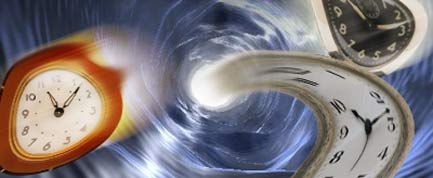Time Travel Machine Outlined

A new concept for a time machine could possibly enable distant future generations to travel into the past, research now suggests.
Unlike past ideas for time machines, this new concept does not require exotic, theoretical forms of matter. Still, this new idea requires technology far more advanced than anything existing today, and major questions remain as to whether any time machine would ever prove stable enough to enable actual travel back in time.
Time machine researchers often investigate gravity, which essentially arises when matter bends space and time. Time travel research is based on bending space-time so far that time lines actually turn back on themselves to form a loop, technically known as a "closed time-like curve."
"We know that bending does happen all the time, but we want the bending to be strong enough and to take a special form where the lines of time make closed loops," said theoretical physicist Amos Ori at the Technion-Israel Institute of Technology in Haifa. "We are trying to find out if it is possible to manipulate space-time to develop in such a way."
Many scientists are skeptical as to whether or not time travel is possible. For instance, time machines often are thought to need an exotic form of matter with so-called "negative energy density." Such exotic matter has bizarre properties, including moving in the opposite direction of normal matter when pushed. Such matter could theoretically exist, but if it did, it might be present only in quantities too small for the construction of a time machine.
Ori's latest research suggests time machines are possible without exotic matter, eliminating a barrier to time travel. His work begins with a donut-shaped hole enveloped within a sphere of normal matter.
"We're talking about these closed loops of time, and the simplest kind of closed loops are circles, which is why we have this ring-shaped hole," Ori explained.
Get the world’s most fascinating discoveries delivered straight to your inbox.
Inside this donut-shaped vacuum, space-time could get bent upon itself using focused gravitational fields to form a closed time-like curve. To go back in time, a traveler would race around inside the donut, going further back into the past with each lap.
"The machine is space-time itself," Ori said. "If we were to create an area with a warp like this in space that would enable time lines to close on themselves, it might enable future generations to return to visit our time."
Ori emphasized one significant limitation of this time machine—"it can't be used to travel to a time before the time machine was constructed." His findings are detailed in the Aug. 3 issue of the journal Physical Review D.
A number of obstacles remain, however. The gravitational fields required to make such a closed time-like curve would have to be very strong, "on the order of what you might find close to a black hole," Ori told LiveScience. "We don't have any way of creating such strong gravitational fields today, and we certainly have no way of manipulating any such gravitational fields."
Even if time machines were technically feasible, the gravitational fields involved need to be manipulated in very specific, accurate ways, and Ori said his calculations suggest any time machine could be very unstable, meaning "the tiniest deviations might keep one from working. We need to explore the problem of stability of time machines further."
Theoretical physicist Ken Olum of Tufts University in Medford, Mass., who did not participate in this study, was skeptical concerning how this new model claimed to sidestep prior theoretical objections to time travel.
Still, Olum noted, "It's important if it's right—that there really is some kind of loophole. So this should be scrutinized very closely." The point of such work, he added, was to "expand the bounds of what's possible, what kind of things we can have and what kinds of things we cannot have."
- Top 10 Time Travel Tales
- You Can't Travel Back in Time, Scientists Say
- Video: Can You Time Travel?

